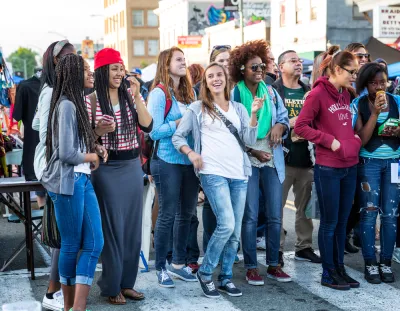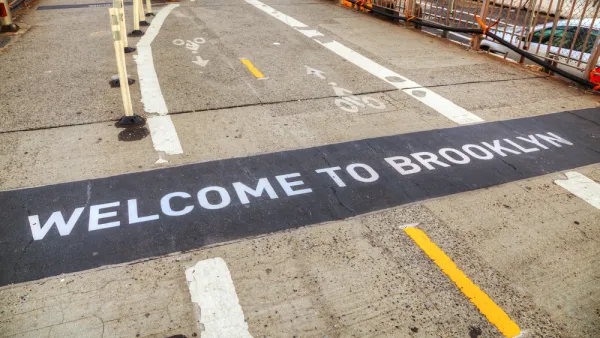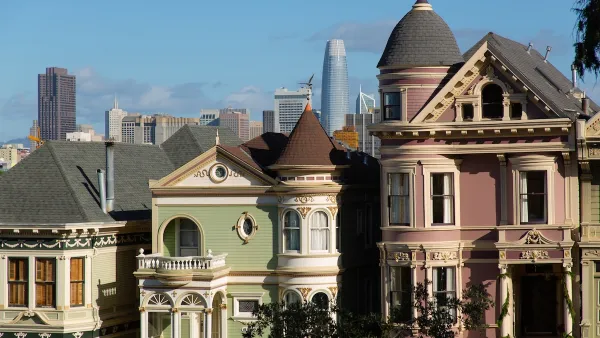In some American cities, the white population is growing while the black population is declining. Is this a result of gentrification or of black upward mobility?

In a recent blog post, one of my favorite urban affairs bloggers, Pete Saunders, writes in that eight of the 20 largest American urbanized areas (Los Angeles,Chicago, Detroit, San Francisco, Seattle,Tampa, Baltimore, St. Louis), the central city's white population grew while the central city's black population declined. And in all but two of these (Los Angeles and San Francisco) the black population grew in suburbia.
It seems to me that there are two possible interpretations of this data:
*The "Gentrification/Displacement Story." According to this story, because blacks tend to be poorer than whites, they tend to be priced out of central cities, and are being forced into cheaper suburbs.
*The "Upward Mobility Story." According to this story (which Saunders seems to prefer), black suburbanization is evidence of affluence rather than poverty. As middle-class blacks are gaining wealth, they are leaving decaying urban neighborhoods for the relative safety of suburbia.
So how can we figure out which story is closer to reality?
It seems to me that if the first story is true, the blacks leaving cities would tend to be the poorest, while better-off blacks get to stay. Thus, central city poverty rates would have declined in recent years. By contrast, if the second story is true, we would see higher rates of black poverty in the central cities, as better-off blacks moved to suburbia.
In all six cities* where black suburbanization was most pronounced (that is, where black urban population declined, white urban population did not, and black suburban population grew) black poverty grew between 2012 and 2015. Sometimes, the rise was not statistically significant – for example, in Baltimore, the black urban poverty rate rose from 27.2% to 28.1%.** Similarly, in St. Louis the black poverty rate grew from 37.7% to 38.1%. On the other hand, in Seattle, the black poverty rate grew from 28.5% to 33.6%, the largest increase among these six cities. By contrast, white poverty rates were stable in all six cities—in all but Detroit, the poverty rate grew or declined by less than 1 point. (In Detroit it rose from 37.3% to 39.6%.) In all of these cities, poverty rates for both racial groups were lower in 1999, reflecting (I suspect) the Great Recession.
So to the extent the evidence tells any story at all, it suggests that blacks moving to the suburbs were middle-class (or at least nonpoor)—which in turn suggests that black migration in these places might be a result of upward mobility rather than gentrification-related displacement.
*That is, the eight cities mentioned at the start of this post, minus Los Angeles and San Francisco.
*The data supporting this discussion is here.

Analysis: Cybertruck Fatality Rate Far Exceeds That of Ford Pinto
The Tesla Cybertruck was recalled seven times last year.

National Parks Layoffs Will Cause Communities to Lose Billions
Thousands of essential park workers were laid off this week, just before the busy spring break season.

Retro-silient?: America’s First “Eco-burb,” The Woodlands Turns 50
A master-planned community north of Houston offers lessons on green infrastructure and resilient design, but falls short of its founder’s lofty affordability and walkability goals.

Test News Post 1
This is a summary

Analysis: Cybertruck Fatality Rate Far Exceeds That of Ford Pinto
The Tesla Cybertruck was recalled seven times last year.

Test News Headline 46
Test for the image on the front page.
Urban Design for Planners 1: Software Tools
This six-course series explores essential urban design concepts using open source software and equips planners with the tools they need to participate fully in the urban design process.
Planning for Universal Design
Learn the tools for implementing Universal Design in planning regulations.
EMC Planning Group, Inc.
Planetizen
Planetizen
Mpact (formerly Rail~Volution)
Great Falls Development Authority, Inc.
HUDs Office of Policy Development and Research
NYU Wagner Graduate School of Public Service





























